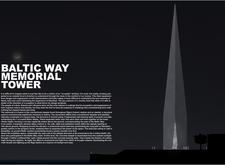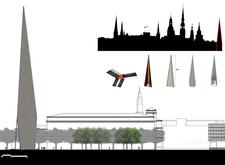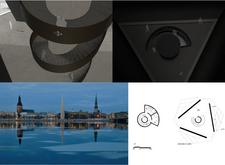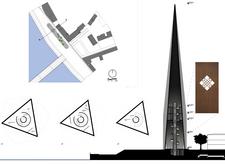5 key facts about this project
# Analytical Report on Baltic Way Memorial Tower
## Overview
The Baltic Way Memorial Tower is situated in Riga, Latvia, commemorating the significant events of the Baltic Way, a peaceful protest advocating for freedom and independence during the late 20th century. The tower serves as both a memorial and a gathering space, reflecting the historical context of its site and the collective memory of the Baltic states’ struggle for sovereignty. The design integrates contemporary architectural elements with a deep respect for cultural identity, facilitating a dialogue between past and present.
## Vertical Design and Cultural Resonance
The architectural form of the tower emphasizes verticality, symbolizing aspirations for freedom and resilience. This soaring height not only elevates the memorial above its surroundings but also invites contemplation from observers, reinforcing the connection to the ideals represented. The geometric shapes, characterized by sharp angles and a pyramidal silhouette, contrast with the softer lines of the adjacent landscape. This deliberate juxtaposition enhances the tower's visibility and reinforces its role as a modern landmark steeped in historical significance.
The structure is particularly significant as it occupies the historical site where two million people formed a human chain across the Baltic states on August 23, 1989, advocating for independence from Soviet rule. This contextual relationship deepens the memorial's meaning, linking its physical presence to a pivotal moment in Latvia's national narrative.
## Material Selection and Environmental Interaction
The construction of the Baltic Way Memorial Tower utilizes three primary materials: concrete, glass, and steel. Concrete provides robustness and durability, forming the structural core of the tower. A smooth finish may be applied to convey continuity, emphasizing the memorial's significance. Glass elements are strategically incorporated to foster transparency, allowing natural light to flow through the interior spaces and connect visitors with the surrounding environment. This choice promotes an open, inviting atmosphere suitable for reflection.
Structural steel reinforces the design, particularly in cantilevered sections and dynamic angular features, ensuring stability without compromising the aesthetic intent. Thoughtful lighting design enhances the tower's presence at night, illuminating its form and casting shadows that create a contemplative ambiance, while landscaping elements such as green spaces and pathways enhance visitor accessibility and engagement with the memorial.






















































